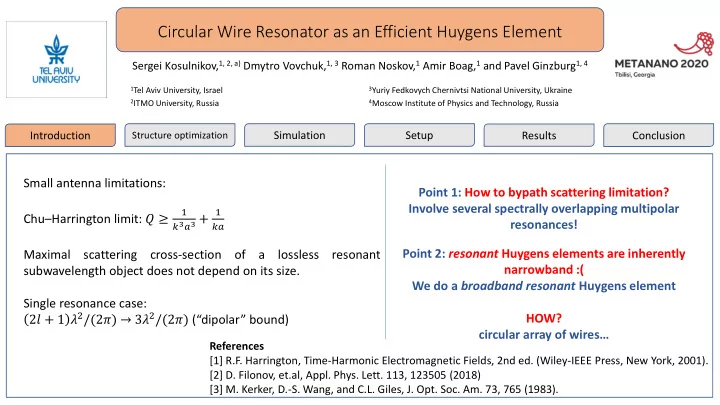

Circular Wire Resonator as an Efficient Huygens Element Sergei Kosulnikov, 1, 2, a) Dmytro Vovchuk, 1, 3 Roman Noskov, 1 Amir Boag, 1 and Pavel Ginzburg 1, 4 1 Tel Aviv University, Israel 3 Yuriy Fedkovych Chernivtsi National University, Ukraine 2 ITMO University, Russia 4 Moscow Institute of Physics and Technology, Russia Introduction Simulation Setup Results Conclusion Structure optimization Small antenna limitations: Point 1: How to bypath scattering limitation? Involve several spectrally overlapping multipolar 1 1 Chu – Harrington limit: 𝑅 ≥ 𝑙 3 𝑏 3 + resonances! 𝑙𝑏 Point 2: resonant Huygens elements are inherently Maximal scattering cross-section of a lossless resonant narrowband :( subwavelength object does not depend on its size. We do a broadband resonant Huygens element Single resonance case: 2𝑚 + 1 𝜇 2 /(2𝜌) → 3𝜇 2 /(2𝜌) (“dipolar” bound) HOW? circular array of wires… References [1] R.F. Harrington, Time-Harmonic Electromagnetic Fields, 2nd ed. (Wiley-IEEE Press, New York, 2001). [2] D. Filonov, et.al, Appl. Phys. Lett. 113, 123505 (2018) [3] M. Kerker, D.-S. Wang, and C.L. Giles, J. Opt. Soc. Am. 73, 765 (1983).
Circular Wire Resonator as an Efficient Huygens Element Sergei Kosulnikov, Dmytro Vovchuk, Roman Noskov, Amir Boag, and Pavel Ginzburg Introduction Simulation Setup Results Conclusion Structure optimization Circular wire array Scattering efficiency plane wave illumination, vertical polarization We proceed with 11 wires…
Circular Wire Resonator as an Efficient Huygens Element Sergei Kosulnikov, Dmytro Vovchuk, Roman Noskov, Amir Boag, and Pavel Ginzburg Introduction Simulation Setup Results Conclusion Structure optimization Multipole decomposition of the scattering efficiency Forward / backward directions with respect to the wave incidence
Circular Wire Resonator as an Efficient Huygens Element Sergei Kosulnikov, Dmytro Vovchuk, Roman Noskov, Amir Boag, and Pavel Ginzburg Introduction Simulation Setup Results Conclusion Structure optimization Three types of the experimental setups a) Near-to-near b) Near-to-far c) Far-to-far
Circular Wire Resonator as an Efficient Huygens Element Sergei Kosulnikov, Dmytro Vovchuk, Roman Noskov, Amir Boag, and Pavel Ginzburg Introduction Simulation Setup Results Conclusion Structure optimization Characterization of the resonant modes Forward and the backward scattering efficiency Experimental data experiment simulations Az. order 0 1 2 3 4 4 5 5 f, GHz - - 2.055 2.181 2.23 2.239 2.253 2.258 Q-factor - - 32.5 220 1316 1595 1211 2579 Numerical data M-poles M16-pole M16-pole M32-pole M32-pole MQ+EO MD+EQ MO ED f, GHz 1.773 1.887 2.094 2.217 2.273 2.295 Q-factor 1.1 3.8 20 120 873 5599
Circular Wire Resonator as an Efficient Huygens Element Sergei Kosulnikov, 1, 2, a) Dmytro Vovchuk, 1, 3 Roman Noskov, 1 Amir Boag, 1 and Pavel Ginzburg 1, 4 1 Tel Aviv University, Israel 3 Yuriy Fedkovych Chernivtsi National University, Ukraine 2 ITMO University, Russia 4 Moscow Institute of Physics and Technology, Russia Introduction Simulation Setup Results Conclusion Structure optimization 1. Multipoles analysis shows predominant contribution of magnetic multipoles with respect to electric ones for almost all eigenmodes except from the lowest one. 2. Multipoles contribution to the Huygens element performance have been shown. 3. Scattering efficiency of the demonstrated configuration is 15 times larger than its geometrical cross section and, at the same time, the device demonstrates broadband forward scattering capabilities, obtained at a bandwidth ~ 10% of the carrier frequency in the GHz range. https://arxiv.org/abs/2006.14006 sergeik@mail.tau.ac.il
Recommend
More recommend